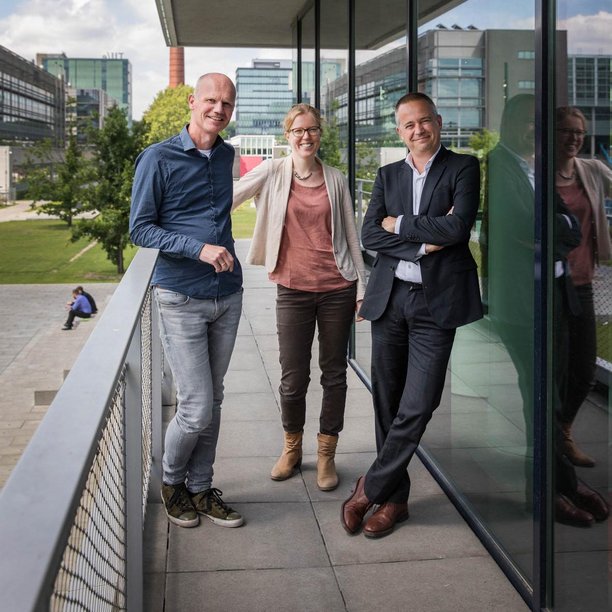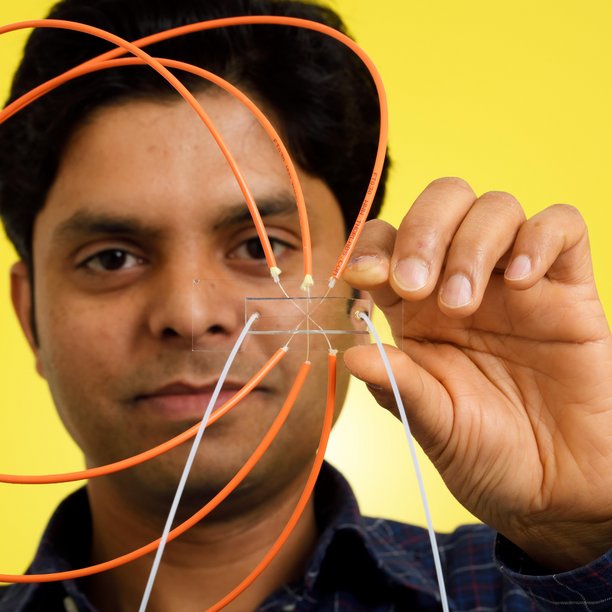This interview focuses on fundamental and applied research in the Soft Matter and Biological Physics group (Professor Kees Storm), the Fluids and Flows group (Assistant Professor Hanneke Gelderblom) and the Transport in Permeable Media group (Associate Professor Henk Huinink).
What have you focused on during the past 12 months?
Kees: “Our work focuses on replicating the properties of the biological materials that make up our cells. Put simply, we want to synthesise sustainable and recyclable self-repairing materials that are capable of assembling themselves like cellular matter. During the past 12 months, my collaboration with Rint Sijbesma in the department of Chemical Engineering at TU/e has resulted in a bio-inspired synthetic material that is, indeed, capable of organising and structuring itself. This all started about 10 years ago when I showed Rint some of our models for biopolymer materials. He saw that these models could be used to produce a synthetic material. The first result was a basic material that captured some of the properties of the living material but which, unlike a cell, was basically passive and inert. Rint’s next stroke of genius involved adding small amounts of a different polymer to create an intelligent material which can autonomously contract like a tiny muscle. The theoretical underpinnings are there, so our focus has now switched to investigating the mechanical responses of this new composite material.”
Hanneke: “I built an experimental set-up that allows you to see bacteria suspended in liquid droplets and track how the bacteria move over time. Basically we make the bacteria fluorescent and can then visualize their movements by illuminating them at a specific wavelength. Why is this important? Well, surface contamination by bacteria is a general problem, but particularly relevant in respect of medical instruments. And a good knowledge of how bacteria behave in droplets can also tell us how contamination spreads when you sneeze or flush the toilet. In hospitals, for example, a good understanding of how droplets that contain bacteria or viruses can be controlled is extremely important. I also started to teach during the past 12 months. The opportunity to teach was one of my reasons for joining the Applied Physics Department.”
Henk: “Our understanding of the processes for storing heat by embedding water and salt in a crystalline matrix has developed significantly. The fact that crystal is a hard material perplexed us initially: you need to change the whole structure to get water into the matrix. We didn’t really understand the mechanisms, but knew that there would be several intermediate stages. We have now identified those intermediate stages and found proof that thin liquid films, highly concentrated ions in water, can exist within a crystalline structure. This means that movement is possible and that new crystal can be fed by old crystal. We have also discovered ways of increasing the crystal’s storage capacity so that more heat can be released.”
TU/e is obviously recognised as a leading university in Applied Physics. Would you recommend TU/e to other academics looking for research opportunities?
Kees: “I graduated from Leiden originally and then worked as a postdoc in Philadelphia, Paris and Amsterdam before coming to Eindhoven. I started on a tenure track here in 2007 and was ultimately appointed full professor in 2017. TU/e embraces Applied Physics in all its aspects and highlights its societal value as well as the fundamental research aspects. Eindhoven is unique in terms of its scale and short lines of communication within a highly connected knowledge ecosystem that includes industry. The department’s highly organised chain of knowledge ensures maximum benefit for everybody. We have a world-leading profile in these areas. I would definitely recommend Eindhoven and TU/e to colleagues looking for research positions.”
Hanneke: “I graduated from Twente and then got involved with a project for ASML here in Eindhoven before joining TU/e. Eindhoven is absolutely the right environment for me, as it allows me to combine my interests in biomedical engineering and fluid physics, and provides ample opportunities in my area of focus. Furthermore I find teaching enormously rewarding. TU/e has given me the chance to spread my wings and develop in the direction I want. It’s a great place for fundamental research, multidisciplinary collaboration and has a strong link to applications.”
Henk: “TU/e and Eindhoven are a hive of activity when it comes to energy technology. We have DIFFER, a strong Energy Technology group in the department of Mechanical Engineering, the Building Performance Group in the department of the Built Environment is looking closely at heat management and there is a strong link with solar cell technology. These separate tracks are now coming together much more. So it’s an exciting time, particularly in my area, and that obviously means opportunities for colleagues looking for research positions. And the people here really want to have an impact on the future.”


